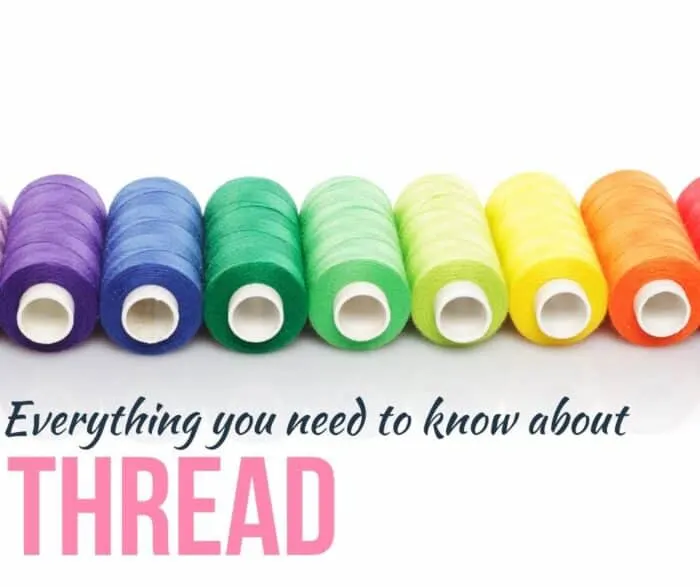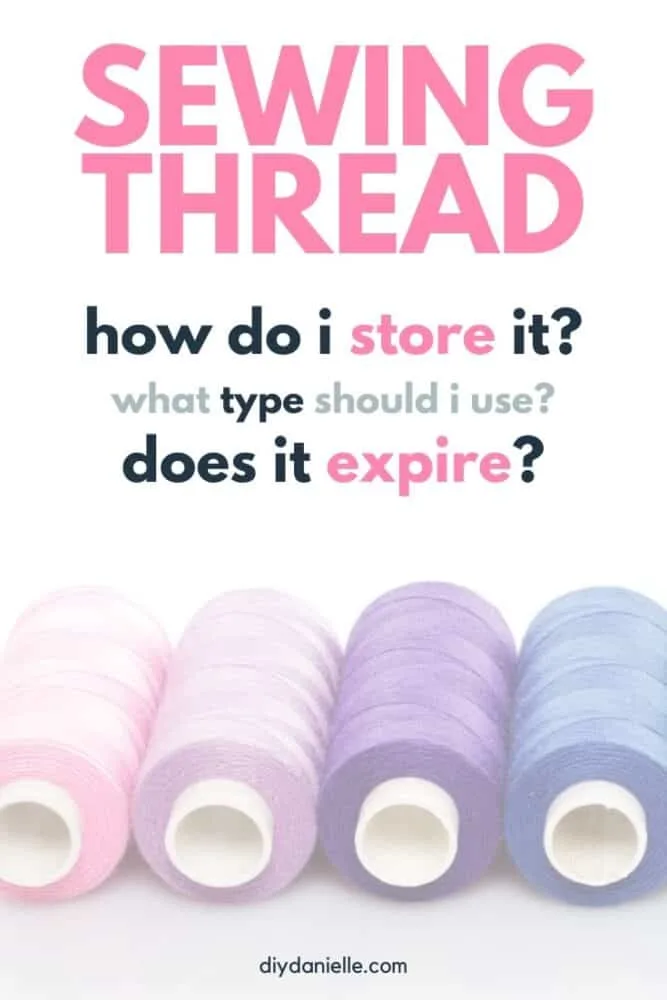
Everything you need to know about THREAD for sewing: Does it expire? What types of thread are there? How do I choose the right thread for my project?
This post may contain affiliate links which may earn me commissions should you click through them and take certain actions. As an affiliate for Amazon, Cricut, xTool, Home Depot, and other sites, I earn from qualifying purchases. Please DIY carefully. View my full legal disclosures here.
Please read the whole post so you don’t miss any important information!
A visit to a fabric store or craft store like Joann will reveal a huge variety of thread. This can be overwhelming for people who don’t know the differences between them all.
Here are a few things you need to know about thread.
There are two general principles to pay attention to when choosing thread (besides color… but color is up to you!): thickness and material.
As you might expect, the thickness and material of thread you’re using will depend largely on the type of sewing you’re doing (embroidery, hand sewing), the machine you’re using (serger, sewing machine), and the fabric you’re using (lightweight, cotton, silk, knit).
Thread Thickness
There are multiple methods for measuring thread thickness, which can be confusing. The two most common methods are Tex and weight.
The Tex System is widely recognized and tells you the thickness of the thread. Larger Tex numbers mean thicker thread. Most sewing machine thread is about T-30, though most home sewing machines can handle up to T-50.
Some thread companies use weight, but contrary to the Tex numbers, smaller weight numbers indicate thicker thread. This is because the weight measurement is actually the length of thread you’d need to have one kilogram of thread. Therefore, if you have a thicker thread, you’d need less of it to achieve one kilometer.
For most projects, you’ll need a thread with a weight of 50. Sometimes thread weight is listed along with the ply number (or the number of strands twisted together to form the thread). So, thread with a listed weight of 50/3 has a weight of 50 and is 3-ply.
For most sewing machine projects, you’ll use an all-purpose thread that’s T-30 or 50/3. The Coats and Clark Dual Duty and Gutterman thread you’re likely to find most easily at a Joann or a similar store is this thickness.
Embroidery thread is usually thicker, as is topstitching thread and thread made for heavier fabrics like denim.
Many people use thicker threads for quilting, too, because it makes the stitches stand out more.
As always, make sure you’re using the correct needle for your project. A larger needle size may be necessary with thicker thread.
Thread Material
Sewing thread is made of various materials, most commonly polyester or cotton. Standard, all-purpose thread is 100% polyester. This works nicely for most machine and hand sewing projects.
Polyester thread has a bit of give so it works well for knit fabrics, and because this thread has a wax or polyester coating, it slides easily through your machine and your fabric.
The other common thread material is cotton. Cotton thread has been used for centuries, but there are some drawbacks to it including that it has low stretch so it’s more prone to breakage. However, many quilters swear by using 100% cotton thread when sewing quilts.
Cotton sewing thread comes in a variety of finishes:
- Mercerized: This is a special treatment that allows for better, richer color. It also increases strength.
- Glazed or coated: This thread has a wax coating applied to it that makes it look glossy, but the wax does come off, so you probably only want to use this for hand sewing. Otherwise, the wax could dirty or clog your machine.
- Gassed: This thread has a clean, silky, polished look to it.
Cotton-wrapped polyester is polyester thread wrapped in cotton, and it usually behaves more like a polyester thread than a cotton thread, so this may be a good choice if you want polyester thread that looks more like cotton.
There are other types of thread that may be useful for different purposes. Nylon thread is strong and stretchy, but will melt at higher temperatures so be careful when ironing.
Monofilament thread is made of nylon and is clear like a very thin fishing line and can be useful for upholstery or quilting.
Rayon is often used for embroidery thread. It is shiny and comes in vibrant colors, but it’s relatively weak, so shouldn’t be used for construction purposes.
Silk thread is strong, flexible, and holds color well. Because it’s fine, it can be used with delicate materials.
Finally, wool thread is often used for hand sewing, but it can also be used for machines as long as it is thin enough.
Using the Correct Thread is Important for Some Projects
Pay attention to directions on your project; some projects require a particular type of thread for the product to come out correctly.
Use polyester thread for cloth diapers, as cotton may cause issues with leaking.
Use cotton thread for sewing soup cozies or anything that might be put in the microwave; polyester (synthetic) may be more prone to cause a fire. This is particularly important as you’ll need to change out both the bobbin and top thread.
Serger or Coverstitch Thread
Thread for your serger and coverstitch is sold in cones, but that’s not the only thing that makes it different from other sewing machine thread.
Serger thread is typically 40 wt. polyester thread that is coated to allow it to stand up to the high speed and high tension of a serger or coverstitch.
Some people like to use woolly nylon thread (AKA textured nylon thread) in their machines, especially in the loopers. This thread is stretchy and strong so it is especially useful for knit fabrics. Because this thread is “woolly” and has a more spongey, yarn-like texture, it’s especially nice for rolled hems because it expands to fill the space between the threads.
Thread Brands and Quality
Many great thread brands exist, but there are a couple that are more commonly used than others.
Coats and Clark makes good all-purpose thread, and Gutterman is an excellent brand as well. Both companies make thread in a huge rainbow of colors.
Maxi Lock thread is commonly used for sergers and coverstitch machines.
A high quality thread should have an even thickness on all of the thread on the spool.
Some people think that using a high quality thread means that your thread shouldn’t break or snap, but as always with sewing, it’s not just about the thread!
Make sure you’re using the right needle and that your machine is threaded correctly. Also, pay attention to tension, as using the incorrect tension for your thread, needle, and fabric can cause breakage.
If my machine is acting up, I will troubleshoot the tension, re-wind my bobbin, re-thread, etc., but if that doesn’t work, I will switch out my thread. Sometimes that particular spool of thread isn’t great quality, even if the brand is normally fine.
Storing Thread
You should store thread in a climate controlled area and ideally keep it somewhere it will not accumulate dust.
While thread racks are fun ways to store thread, thread is exposed to dust, sunlight, and other elements when it is left out.
Closed containers such as this one help keep protect and organize your thread.
Does Thread Expire?
The short answer is yes, but there’s no set date that thread expires.
Like most products, thread breaks down over time; the speed is impacted by factors such as:
- how it was stored,
- where it was stored,
- the type of thread, and
- the original quality of the thread
If you threw some thread into your compost bin, it would break down relatively quickly. If you store your thread carefully in a climate controlled room, it will last longer.
Natural fibers like cotton or silk may break down more quickly than synthetics such as polyester.
While the thread you buy should last a few years, the hand-me-down thread from Great Grandma might be better to keep as decor or a memento.
Love this series of blog posts? Learn how to properly thread a sewing machine, adjust your machine’s tension, how to choose the right needle for a project, and more in Sewing 101. I’ll even show you how to setup a fabric-friendly she shed for sewing!
Please share and pin this post! If you make this project, share it in our Stuff Mama Makes Facebook Group. We have regular giveaways for gift cards to craft stores. You can also tag me on Instagram @doityourselfdanielle; I love seeing everything you make!

This post was written for DIYDanielle by Becky McGill-Wilkinson.
Learn about types of thread for sewing in this Google Web Story
